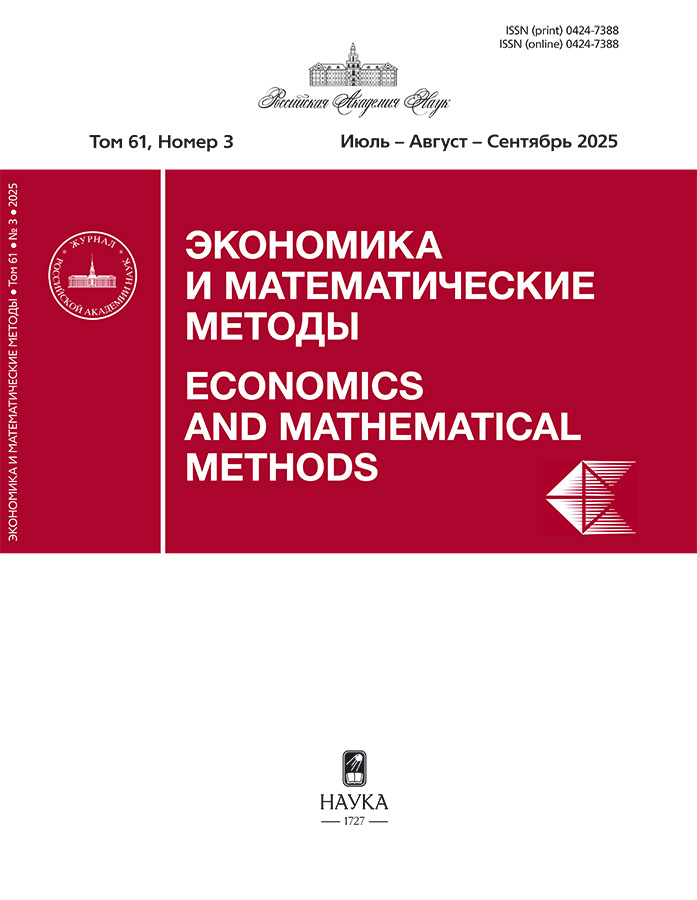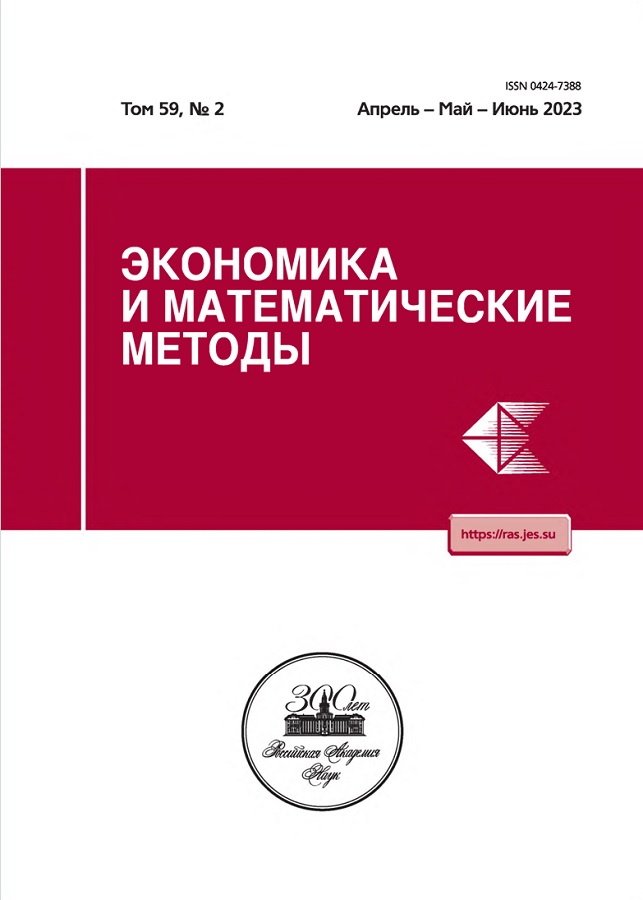Влияние пандемии COVID-19 на социально-экономическое развитие региона
- Авторы: Голованов О.А.1, Тырсин А.Н.1,2, Васильева Е.В.1
-
Учреждения:
- Институт экономики УрО РАН
- Уральский федеральный университет
- Выпуск: Том 59, № 2 (2023)
- Страницы: 54-67
- Раздел: Статьи
- URL: https://clinpractice.ru/0424-7388/article/view/653341
- DOI: https://doi.org/10.31857/S042473880022737-9
- ID: 653341
Цитировать
Полный текст
Аннотация
В статье представлен анализ последствий экономической нестабильности, вызванной пандемией COVID‑19, для социально‑экономического развития региона. Исследование проводилось на примере Свердловской области по данным Федеральной службы государственной статистики. В статье поставлены и решены три задачи исследования. Во‑первых, оценить, насколько в общем изменилось социально‑экономическое состояние региона в результате пандемии COVID‑19. Во‑вторых, выявить влияние пандемии COVID‑19 на характер и структуру взаимосвязей между социально‑экономическими показателями региона. В‑третьих, проанализировать влияние пандемии COVID‑19 на тенденции социально‑экономических показателей региона с учетом их возможного запаздывания и сезонного колебания. Первая задача решается с помощью статистических методов распознавания образов, вторая задача — методами многомерного корреляционного анализа. Для решения третьей задачи использованы стохастические модели временных рядов. Наибольший вклад в разделение на кластеры оказало число родившихся, оборот общественного питания и объем товаров, работ и услуг, выполненных собственными силами; в их динамике наиболее явно прослеживается влияние пандемии COVID‑19 в Свердловской области. Многомерный корреляционный анализ позволил установить, что в результате введения ограничительных и поддерживающих мер сформировались разнонаправленные тенденции динамики социально‑экономических показателей региона, которые нарушили ранее сложившиеся взаимосвязи между ними. Исходя же из полученных коэффициентов авторегрессионной модели, можно обнаружить некоторую закономерность, заключающуюся в росте влияния краткосрочных (лаг 1 и 3 месяца) и в уменьшении влияния долгосрочных (лаг 12 месяцев) изменений показателей. Согласно полученным расчетам экономике Свердловской области за анализируемый не удалось преодолеть дестабилизирующее влияние последствий пандемии COVID‑19.
Об авторах
Олег Александрович Голованов
Институт экономики УрО РАНг. Екатеринбург, Россия (620014, г. Екатеринбург, ул. Московская, 29)
Александр Николаевич Тырсин
Институт экономики УрО РАН; Уральский федеральный университетг. Екатеринбург, Россия (620014, г. Екатеринбург, ул. Московская, 29)
Елена Витальевна Васильева
Институт экономики УрО РАНРоссийская Федерация
Список литературы
- Айвазян С.А., Бухштабер В.М., Енюков И.С., Мешалкин Л.Д. (1989). Прикладная статистика: Классификация и снижение размерности. М.: Финансы и статистика. 607 с.
- Айвазян С.А., Енюков И.С., Мешалкин Л.Д. (1985). Прикладная статистика: Исследование зависимостей. М.: Финансы и статистика. 487 с.
- Васиев М., Би К., Денисов А., Бочарников В. (2020). Влияние пандемии covid-19 на устойчивость экономики Китая // Форсайт. Т. 14. № 2. С. 7-22.
- Вероятность и математическая статистика: Энциклопедия / Гл. ред. Ю.В. Прохоров. М.: Большая Российская энциклопедия. 910 с.
- Вучков И., Бояджиева Л., Солаков Е. (1987). Прикладной линейный регрессионный анализ / пер. с болг. М.: Финансы и статистика. 239 с.
- Голованов О.А., Тырсин А.Н., Васильева Е.В. (2022). Оценка влияния пандемии COVID‑19 на тренды социально-экономического развития региона России: кейс Свердловской области // Journal of Applied Economic Research. Т. 21. № 2. С. 257-281. doi: 10.15826/vestnik.2022.21.2.010.
- Демиденко Е.З. (1981). Линейная и нелинейная регрессия. М.: Финансы и статистика. 302 с.
- Лукашин Ю.П. (2003). Адаптивные методы краткосрочного прогнозирования временных рядов. М.: Финансы и статистика. 416 с.
- Мау В.А. (2020a). Экономика и политика 2019-2020 гг.: глобальные вызовы и национальные ответы // Вопросы экономики. № 3. С. 5-27. doi: 10.32609/0042-8736-2020-3-5-27
- Мау В.А. (2020b). Экономика непредсказуемого: на пути к новой парадигме Образовательная политика. № 1 (81). С. 8-12.
- Омельяновский В.В., Авксентьева М.В., Деркач Е.В., Свешникова Н.Д. (2011). Анализ стоимости болезни проблемы и пути решения // Педиатрическая фармакология. Т. 8, №3. С. 6-12.
- Онищенко Г.Г., Сизикова Т.Е., Лебедев В.Н., Борисевич С.В. (2022). Вариант “омикронˮ вируса SARS-COV-2 как доминантный агент нового подъёма заболевания в условиях пандемии COVID-19 // Вестник Российской академии наук. Т. 92. № 7. С. 636-646. doi: 10.31857/S0869587322070131.
- Смирнов Е.Н. (2020). «Мировая экономика коронавируса»: поиск оптимальных путей преодоления последствий кризиса // Вестник МГИМО-Университета. №13(3). С. 243-266 doi: 10.24833/2071-8160-2020-3-72-243-266.
- Тырсин А.Н. (2005). Метод обнаружения полиномиального тренда временного ряда // Обозрение прикладной и промышленной математики. Т. 12. № 2. С. 533-534.
- Тырсин А.Н. (2022). Скалярная мера взаимосвязи между несколькими случайными векторами // Заводская лаборатория. Диагностика материалов. Т. 88. № 3. С. 73–80. doi: 10.26896/1028-6861-2022-88-3-73-80.
- Тырсин А.Н., Голованов О.А. (2021). Динамическое регрессионное моделирование на основе градиентного спуска по узловым прямым // Современные наукоемкие технологии. № 10. С. 88-93. doi: 10.17513/snt.38859.
- Ханин Г.И. (2019). Итоги экономического развития РФ в 1 квартале 2019 года: экономический кризис усиливается // Вопросы регулирования экономики. Т. 10, №2. С. 64-71. doi: 10.17835/2078-5429.2019.10.2.064-071.
- Цветков В.А., Дудин М.Н. (2020). Пандемия COVID-19 как угроза продовольственной и экономической безопасности страны // Экономика и управление. №26(4). С. 334-344. doi: 10.35854/1998-1627-2020-4-334-344.
- Цухло С.В. (2021). Адаптация российской промышленности к кризису 2020 г. // Экономическое развитие России. Т. 28, №10. С. 16-18.
- Шмат В. (2022). Экономический рост или гармоничное социально-экономическое развитие? Часть I. Теоретико-методический взгляд. // ECO. №52(6). С. 89-110. doi: 10.30680/ECO0131-7652-2022-6-89-110.
- Эсбенсен К. (2005). Анализ многомерных данных. Избранные главы: пер. с англ. Черноголовка: Изд-во ИПХФ РАН. 160 с.
- Ягудина Р.И., Зинчук И.Ю., Литвиненко М.М. (2012). Анализ «Стоимости болезни»: виды, методология, особенности проведения в Российской Федерации // Фармакоэкономика. Современная фармакоэкономика и фармакоэпидемиология. Т. 5, №1. С. 4-9.
- Box G.E.P., Jenkins G.M., Reinsel G.C., Ljung G.M. (2015). Time Series Analysis: Forecasting and Control. 5th ed. Hoboken, NJ, US: Wiley. 712 p.
- Brahmbhatt M., Dutta A. (2008). On SARS Type Economic Effects During Infectious Disease Outbreaks. World Bank Policy Research Working Paper. No. 4466. Режим доступа: https://ssrn.com/abstract=1081740.
- Hardle W.K., Simar L. (2019). Applied Multivariate Statistical Analysis. 5th.ed. Springer. 558 p.
- Jonung L., Roeger W. (2006). The Macroeconomic Effects of a Pandemic in Europe – a Model-Based Assessment. doi: 10.2139/ssrn.920851.
- Pena D., Rodriguez J. (2003). Descriptive Measures of Multivariate Scatter and Linear Dependence // Journal of Multivariate Analysis. Vol. 85. No 2. P. 361-374. doi: 10.1016/S0047-259X(02)00061-1
- Suhrcke M., Rocco L., McKee M., Mazzuco S., Urban D., Steinherr A. (2008). Экономические последствия неинфекционных заболеваний и травм в российской федерации. ВОЗ. 97 с.
- Ward J.D., Sutton P.C., Werner A.D., Costanza R., Mohr S.H., Simmons C.T. (2016). Is Decoupling GDP Growth from Environmental Impact Possible? // PLoS ONE №11(10). e0164733. doi: 10.1371/journal.pone.0164733.
Дополнительные файлы











